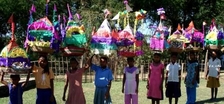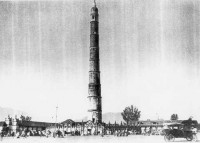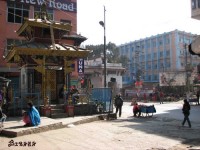Ten important festivals of Tharu
One of the many ethnic groups of Nepal, Tharu community is rich in terms of culture and religion. Devoted and committed, there are several festivals that make this ethnic community more colorful and bright. Out of many, ten important festivals of Tharu community in Nepal are mentioned below:
Joorshital/Siruwa
Celebrated on the first day of the Nepali year, the festival of Joorshital is celebrated by sprinkling water on each other. Usually the elders start the festival by putting water on the forehead and head of the young ones with their blessings and the young people put water on the feet of the elders to pay their respects. People of similar age sprinkle water on each other’s body. On this day, people get up early in the morning, take bath and wear clean and new clothes. They also visit fairs that are held annually at the places of worship during the day time and in Eastern Terai, people visit the Semnath Dham in Saptari district and Salahesh Fulwair in the Siraha district.
Akharhi Pawain
Celebrated by offering rice pudding to the home deity, Aakhari Pawain falls on the month of June-July. On this day, the house and the surrounding are cleaned and the worshipper who offers the pudding to the deity keeps fast and eats only after worshiping.
Chauthichan
Chauthichan, celebrated on the day of Ganesh Chaturthi festival, is celebrated by worshiping the moon and on the evening of the occasion, puwa (sweet cake), kheer (rice pudding) and other offerings are made to the moon. The worshiper keeps fast for the entire day and eats only after the puja is over in the evening.
Jitiya
One of the most important festivals celebrated by Tharu women, Jitiya is celebrated by keeping fast by the mothers for their sons. On this day, the brothers visit their sisters’ home to invite them and take them to their maternal home where they will be celebrating this festival and also Saamaa Chakewa. The married women keep waterless fast and worship Lord Jitmahan on this occasion.
Dashami
Falling after ten days of Jitiya is the Dashain festival during which, the Tharus worship their home deity and the village deity Rajaji/Dihibar Baba. On this day, the villagers offer clay lamps ‘diyas’ and incense sticks to the village deity at the place of village worship, which is locally known as Than. Dain Jogin, the evil eyes, are made at the entrance of each house and granary on the fifth day which are erased and replaced by red and white patches of vermilion and rice flour paste on the seventh day. On the ninth and tenth days, the villagers worship the clay sculptures of gods and goddesses (Durga, Kali, Laxmi, Saraswati, Ganesh and Kartik). These ten days are thought to be auspicious to learn the trade and tricks of wizard and witchcraft as they believe that all doors and windows to all the 10 directions are opened during this time.
Shukrati
The festival of Shukrati of the Tharu is similar to the festival of Tihar or Deepawali, the color of lights. The Tharus prepare a baton of jute sticks ‘santhi’ and ‘sabai’, the wild rope grass on the day of Laxmi puja and in the evening, they light the batons ‘Hunke Hukar’ from the lamp offered to the home deity and play with the burning batons among their friends and relatives at an open space. They also chant ‘Hunke Hunkar, Behan Bagiya’ which means ‘ the day after will be celebrated by eating bagiya.
All the agricultural tools like plough, spade, axe, scales, weights, etc. are washed, oiled and sprinkled with rice flour paste and vermilion on the day of Govardhan puja. From the cow dung, they also make godaha/godahaini (of human form) and leave it for the night in the gahli (cow shed). The godaha/godahaini is made into a chirpi (dung cake), the next day and are dried and stored in a safe place.
After making a bale of grass called ‘hurra‘, the cattle herders collect money from each household. After washing the cattle, the mixture of rice bran, mustard cake, hay and bamboo leaves are fed to them and mustard oil, rice flour paste and vermilion are applied to their horns coloring the cattle are colored further. Also the essential oil extracted from the wild aromatic plant ‘Dulfi’ is fed to them and then, then cattle are taken to the village grazing field and the herders organize bull fights and buffalo fights where the winners will get the bulk of hurra and claim the prize money.
Saamaa Chakewa
Celebrated on the month of Kartik (October-November), Saamaa Chakewa is celebrated to honor the relationship between brothers and sisters and husbands and wives. On this day, the clay statues of Saamaa, Chakewa, Sathbhainya, Chugala, dog and others (characters that are mentioned in the story of Saamaa Chakewa) are made and worshiped by putting them in a decorated bamboo basket, carrying the basket on the heads and singing songs blessing their brothers. Until the full moon day, they gather at different houses and sing songs and on the final day, the brothers help the sisters to make a temple out of bamboo and paper which is laid at the center of a pond.
Neman
Celebrated on the month of November, Neman is the ritual of honoring the new harvest. On this day, the chirpi made during Shukrati is used to light fire and cook the first grain harvested from the field and it is offered to the home deity. The Tharus consume the newly harvested grain only after celebrating Neman.
Maaghi/Tila Sankarait
The greatest festival of the Tharus, Maaghi is marked by taking bath at the nearest natural water sources like rivers and ponds. On this day, the delicacies like sesame laddus (tiluwa laddu), rice pudding with sesame seeds (teel khichri), sticky rice (chichri), fish and meat are made and served. This festival is also called Tila Sankarait in the eastern Terai which is named after eating the dishes made from sesame seeds (til) while in western Terai, the festival is known as Maaghi, named after the month on which it falls. It is also considered as the New Year and the households and villages select their respective leaders, known as Badghars, on this day.
Faguwa
The festival of colors, known as Holi in Nepali is called Faguwa in Tharu language. This day is celebrated with much enthusiasm and joy by spearing colors on each other, sprinkling waters on each other and playing dholak (a type of drum) and singing jogira, the obscene song. On this day, bhang, a concoction of sugar and weed is drunk widely.
(Photo and text reference: Voice of Tharus- blog-site).








